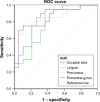Disrupted resting-state spontaneous neural activity in stable COPD
- PMID: 30880940
- PMCID: PMC6398400
- DOI: 10.2147/COPD.S190671
Disrupted resting-state spontaneous neural activity in stable COPD
Abstract
Introduction and aim: Abnormal brain structure and function in COPD has been reported on MRI. However, the deficit in local synchronization of spontaneous activity in patients with stable COPD remains unknown. The main aim of the present study was to explore spontaneous brain activity in patients with COPD compared with normal controls using the regional homogeneity (ReHo) method based on resting-state functional MRI.
Methods: Nineteen patients with stable COPD and 20 well-matched (including age, sex, and number of years of education) normal controls who were recruited for the present study underwent resting-state functional MRI examinations and a series of neuropsychological and clinical assessments. The ReHo method was used to assess the strength of local brain signal synchrony. The mean ReHo values in brain areas with abnormal ReHo were evaluated with a receiver operating characteristic curve. The relationships between the brain regions with altered ReHo values and the clinical and neuropsychological parameters in COPD patients were assessed using Pearson's correlation.
Results: Patients with COPD showed significantly lower ReHo values in the left occipital lobe and the right lingual, bilateral precuneus, and right precentral gyrus. The result of receiver operating characteristic curve analysis showed that the altered average ReHo values have high efficacy for distinguishing function. The mean lower ReHo values in the precuneus gyrus showed a significant positive correlation with FEV1%, FEV1/FVC, and orientation function but a significant negative correlation with arterial partial pressure of carbon dioxide.
Conclusion: The COPD patients demonstrated abnormal synchrony of regional spontaneous activity, and the regions with abnormal activity were all correlated with visual processing pathways, which might provide us with a new perspective to further understand the underlying pathophysiology of cognitive impairment in patients with COPD.
Keywords: blood oxygen-level-dependent; chronic obstructive pulmonary disease; regional homogeneity; resting-state functional magnetic resonance imaging; visual processing pathways.
Conflict of interest statement
Disclosure The authors report no conflicts of interest in this work.
Figures





Similar articles
-
The Abnormal Alternations of Brain Imaging in Patients with Chronic Obstructive Pulmonary Disease: A Systematic Review.J Alzheimers Dis Rep. 2023 Aug 18;7(1):901-919. doi: 10.3233/ADR-220083. eCollection 2023. J Alzheimers Dis Rep. 2023. PMID: 37662615 Free PMC article.
-
Abnormal intrinsic functional hubs and connectivity in stable patients with COPD: a resting-state MRI study.Brain Imaging Behav. 2020 Apr;14(2):573-585. doi: 10.1007/s11682-019-00130-7. Brain Imaging Behav. 2020. PMID: 31187474 Free PMC article.
-
Altered intrinsic regional brain activity in male patients with severe obstructive sleep apnea: a resting-state functional magnetic resonance imaging study.Neuropsychiatr Dis Treat. 2014 Sep 19;10:1819-26. doi: 10.2147/NDT.S67805. eCollection 2014. Neuropsychiatr Dis Treat. 2014. PMID: 25278755 Free PMC article.
-
Abnormal Regional Spontaneous Neural Activity in Nonarteritic Anterior Ischemic Optic Neuropathy: A Resting-State Functional MRI Study.Neural Plast. 2020 Sep 9;2020:8826787. doi: 10.1155/2020/8826787. eCollection 2020. Neural Plast. 2020. PMID: 32963518 Free PMC article.
-
Intrinsic low-frequency oscillation changes in multiple-frequency bands in stable patients with chronic obstructive pulmonary disease.Brain Imaging Behav. 2021 Aug;15(4):1922-1933. doi: 10.1007/s11682-020-00385-5. Brain Imaging Behav. 2021. PMID: 32880076
Cited by
-
Cerebral neurovascular alterations in stable chronic obstructive pulmonary disease: a preliminary fMRI study.PeerJ. 2022 Nov 14;10:e14249. doi: 10.7717/peerj.14249. eCollection 2022. PeerJ. 2022. PMID: 36405017 Free PMC article.
-
Recent insights into respiratory modulation of brain activity offer new perspectives on cognition and emotion.Biol Psychol. 2022 Apr;170:108316. doi: 10.1016/j.biopsycho.2022.108316. Epub 2022 Mar 12. Biol Psychol. 2022. PMID: 35292337 Free PMC article. Review.
-
The Abnormal Alternations of Brain Imaging in Patients with Chronic Obstructive Pulmonary Disease: A Systematic Review.J Alzheimers Dis Rep. 2023 Aug 18;7(1):901-919. doi: 10.3233/ADR-220083. eCollection 2023. J Alzheimers Dis Rep. 2023. PMID: 37662615 Free PMC article.
-
Relationship between Pulmonary Gas Exchange Function and Brain Uptake Dynamics Investigated with Hyperpolarized 129Xe MR Imaging and Spectroscopy in a Murine Model of Chronic Obstructive Pulmonary Disease.Magn Reson Med Sci. 2025 Jul 31;24(4):2024-0030. doi: 10.2463/mrms.mp.2024-0030. Epub 2024 Jul 6. Magn Reson Med Sci. 2025. PMID: 38839300 Free PMC article.
-
Altered Functional Connectivity during Mild Transient Respiratory Impairment Induced by a Resistive Load.J Clin Med. 2024 Apr 26;13(9):2556. doi: 10.3390/jcm13092556. J Clin Med. 2024. PMID: 38731091 Free PMC article.
References
-
- Vogelmeier CF, Criner GJ, Martinez FJ, et al. Global strategy for the diagnosis, management, and prevention of chronic obstructive lung disease 2017 report. Gold executive summary. Am J Respir Crit Care Med. 2017;195(5):557–582. - PubMed
-
- Baird C, Lovell J, Johnson M, Shiell K, Ibrahim JE. The impact of cognitive impairment on self-management in chronic obstructive pulmonary disease: a systematic review. Respir Med. 2017;129:130–139. - PubMed
-
- Agustí A. Systemic effects of chronic obstructive pulmonary disease: what we know and what we don’t know (but should) Proc Am Thorac Soc. 2007;4(7):522–525. - PubMed
-
- Organizer DC, Goode JA. Systemic Effects of Chronic Obstructive Pulmonary Disease. New York: John Wiley & Sons, Ltd; 2008. pp. 75–84.
-
- Antonelli Incalzi R, Marra C, Giordano A, et al. Cognitive impairment in chronic obstructive pulmonary disease – a neuropsychological and SPECT study. J Neurol. 2003;250(3):325–332. - PubMed
MeSH terms
LinkOut - more resources
Full Text Sources
Medical

